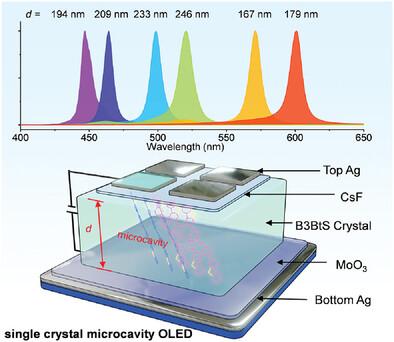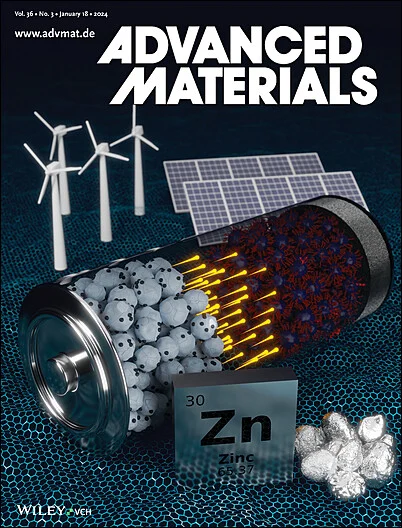Multicolor Organic Single-Crystal Microcavity Light Emitting Diodes With High Color-Purity and High Brightness
IF 27.4
1区 材料科学
Q1 CHEMISTRY, MULTIDISCIPLINARY
引用次数: 0
Abstract
The development of ultra-high-definition (UHD) displays demands organic light-emitting diodes (OLEDs) with high color purity of all three primary colors for a wide color gamut and high brightness essential for future AR/VR applications. However, the vibronic coupling in organic emitters typically results in broad emissions, with a full width at half maximum (FWHM) exceeding 40–50 nm. Herein, multicolor organic single-crystal microcavity light-emitting diodes (SC-MC-OLEDs) are demonstrated by embedding ultrathin 2D organic single crystals (2D-OSCs) between two silver layers that serve as both electrodes and mirrors. By leveraging the microcavity effect, the resonant output frequencies of SC-MC-OLEDs can be continuously tuned from 448 to 602 nm by adjusting the thickness of 2D-OSCs (i.e., the microcavity length), achieving high color purity with a full width at half maximum (FWHM) of <10 nm. Furthermore, the Purcell effect in SC-MC-OLEDs enhances the radiative rate and improves light-coupling efficiency, resulting in a maximum external quantum efficiency (EQE) of up to 4% and minimal efficiency roll-off. Due to the excellent bipolar transport properties of OSCs, the brightness of SC-MC-OLEDs surpasses 106 cd m−2, along with a degree of linear polarization exceeding 0.9, unlocking new application opportunities.

求助全文
约1分钟内获得全文
求助全文
来源期刊

Advanced Materials
工程技术-材料科学:综合
CiteScore
43.00
自引率
4.10%
发文量
2182
审稿时长
2 months
期刊介绍:
Advanced Materials, one of the world's most prestigious journals and the foundation of the Advanced portfolio, is the home of choice for best-in-class materials science for more than 30 years. Following this fast-growing and interdisciplinary field, we are considering and publishing the most important discoveries on any and all materials from materials scientists, chemists, physicists, engineers as well as health and life scientists and bringing you the latest results and trends in modern materials-related research every week.
 求助内容:
求助内容: 应助结果提醒方式:
应助结果提醒方式:


